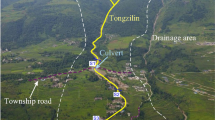Abstract
The August 8, 2010 (henceforth 8.8), massive debris flow in Zhouqu shocked the world with its huge losses. Site investigation and research showed the 8.8 massive debris flow in Zhouqu to be both a natural disaster and a human calamity. This debris flow disaster has six characteristics: heavy loss caused by bursting at midnight, a quickly induced disaster after sudden rainfall, a lack of alertness for light rain beyond the mountains, great magnitude with strong disruption, erosion inside the gully while burial outside, and aggravating loss owing to a chain effect. Both natural conditions and artificial factors led to the outbreak of this massive debris flow.
Access this chapter
Tax calculation will be finalised at checkout
Purchases are for personal use only
Similar content being viewed by others
References
Chen H, Lee CF (2000) Numerical simulation of debris flows. Can Geotech J 37:146–160
Chen H, Lee CF (2003) A dynamic model for rainfall-induced landslides on natural slopes. Geomorphology 51:269–288
Chen H, Dadson S, Chi YG (2006) Recent rainfall-induced landslides and debris flow in northern Taiwan. Geomorphology 77:112–125
Crosta GB (2001) Failure and flow development of a complex slide: the 1993 Sesa, landslide. Eng Geol 59:173–199
Dai FC, Lee CF, Wang SJ (1999) Analysis of rainstorm-induced slide-debris flows on natural terrain of Lantau Island, Hong Kong. Eng Geol 51:279–290
Hungr O (1995) A model for the runout analysis of rapid flow slides. Can Geotech J 32:610–623
Tang C, Rengers N, van Asch ThWJ, Yang YH, Wang GF (2011) Triggering conditions and depositional characteristics of a disastrous debris flow event in Zhouqu city, Gansu Province northwestern China. Nat Hazards Earth Syst Sci 11:2903–2912
Yu B, Yang YH, Su YC et al (2010) Research on the giant debris flow hazards in Zhouqu County, Gansu Province on August 7 2010. J Eng Geol 18(4):437–444
Author information
Authors and Affiliations
Corresponding author
Editor information
Editors and Affiliations
Rights and permissions
Copyright information
© 2015 Springer International Publishing Switzerland
About this paper
Cite this paper
Guoqiang, Y., Maosheng, Z., Genlong, W., Qingming, Z. (2015). A Review of “8.8” Debris Flow in Zhouqu. In: Lollino, G., et al. Engineering Geology for Society and Territory - Volume 2. Springer, Cham. https://doi.org/10.1007/978-3-319-09057-3_83
Download citation
DOI: https://doi.org/10.1007/978-3-319-09057-3_83
Published:
Publisher Name: Springer, Cham
Print ISBN: 978-3-319-09056-6
Online ISBN: 978-3-319-09057-3
eBook Packages: Earth and Environmental ScienceEarth and Environmental Science (R0)




